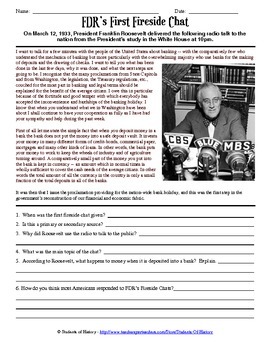

He sometimes asked listeners to make a small but symbolic action to show their support. If you are a guest speaker at a new employee orientation, for example, share a story about your experience as a new employee that they may also be experiencing.Ĥ - Call to Action - FDR typically centered his chats around a specific action that he wanted the listeners to take - usually to support a policy of his. LEADERSHIP LESSON -> Start your presentations by sharing a story to build a connection with your audience. I want to be sure that neither battles nor burdens of office shall ever blind me to an intimate knowledge of the way the American people want to live and the simple purposes for which they put me here." My friends, my enemies, my daily mail bring to me reports of what you are thinking and hoping. I have travelled the country over many times. FDR summed up his approach in his April 1938 chat: "And constantly I seek to look beyond the doors of the White House, beyond the officialdom of the National Capital, into the hopes and fears of men and women in their homes. During the war, he talked about the factory workers and the armed services members he met.
:max_bytes(150000):strip_icc()/Roosevelt-Fireside03-3000-3x2gty-5c521cc54cedfd0001f912d5.jpg)
During the Dust Bowl drought, for example, he talked about the pain and suffering he saw first-hand among farmers. He made a point in many chats to talk about the trips he made around the country and to describe the average Americans he met. He also wanted his listeners to feel like he understood them. He may have pictured his listeners sitting in a chair leaning in to listen to his voice from their home (see photo). He often started his chats by addressing his audience as "My friends" instead of a more formal opening. LEADERSHIP LESSON -> Learn and apply the structured communication techniques that elite consultants, intelligence analysts, and other communication experts also use to convey complex information in a clear and concise way.ģ - Connect with Audience - FDR lived an elitist life but relied on average Americans for his political base, so he knew he needed to build a connection. Tonight, eight weeks later, I come for the second time to give you my report - in the same spirit and by the same means to tell you about what we have been doing and what we are planning to do." For example, here is how he opened his second Fireside Chat in May 1933 on the complex topic of banking: "On a Sunday night a week after my Inauguration I used the radio to tell you about the banking crisis and the measures we were taking to meet it. By laying out a structure at the beginning of the talk, FDR helped his audience absorb and understand the information he was sharing. He put his talks in context of previous chats to connect it to a larger strategy. LEADERSHIP LESSON -> Schedule your mass communications to be short and just infrequent enough so you leave your audience, and you, eagerly awaiting the next one.Ģ - Start with Structure - FDR opened some of his biggest chats by explaining what he was going to cover in the chat and why it was important. Every time I talk over the air it means four or five days of long, overtime work in the preparation of what I say." FDR summed up his timing this way: " The one thing I dread is that my talks should be so frequent as to lose their effectiveness. The vast majority of them were 30 minutes or less and none went over 45 minutes. Perhaps, most importantly, he kept the chats short. He often timed them to be right around milestone events when interest would be highest - like major events in the war and the opening and closing of congressional sessions.

He sometimes started each chat by saying how long it had been since the last one. He spaced his 30 chats 4.6 months apart, on average, and never had more than four in any one year. 1 - Timing is Everything - FDR wanted his Fireside Chats to be big, not-to-miss, events so he timed them appropriately.


 0 kommentar(er)
0 kommentar(er)
